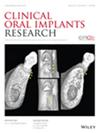Radiographic Peri-Implant Bone Changes in Osteoporotic Women Treated With a Ti-Zr, Bone Level Tapered Implant With a Hydrophilic Surface: A 12-Month Prospective Case-Series
Abstract
Objectives
This study assessed 12-month post-loading 3D peri-implant radiographic bone changes in osteoporotic women receiving a single titanium-zirconium bone-level tapered dental implant with a hydrophilic surface.
Materials and Methods
This was a prospective case series involving 18 post-menopausal osteoporotic women in need of a single dental implant. A standardized CBCT scan was performed after implant placement and at 12 months post-loading to assess peri-implant bone changes. The Implant Stability Quotient (ISQ) was recorded after implant placement, at implant impression, loading, and 12 months post-loading. Peri-implant clinical parameters were recorded at 6 and 12 months post-loading and during the last visit implant survival and success were also evaluated.
Results
Seventeen patients completed all study visits, and implant placement was uneventful for all participants. A statistically significant difference (reduction) from implant placement to 12 months post-loading was observed in terms of radiographic buccal bone width and palatal/lingual width (ΔBw-0: 0.53 mm, p < 0.001 and ΔPw-0: 0.47 mm, p = 0.006), as well as in terms of vertical distance between the implant shoulder and the first bone to implant contact on the buccal and palatal/lingual aspect (ΔBICb: −0.26 mm, p = 0.005 and ΔBICp: −0.46 mm, p = 0.018). ISQ increased during osseointegration, and a high implant survival (100%) and success rate (from 81.3% to 100% based on 3 different sets of criteria) were recorded at 12 months post-loading.
Conclusion
In this case series, osteoporotic patients treated with single titanium-zirconium implants showed high survival rates, predictable 12-month implant outcomes, and physiologic peri-implant bone remodelling.
Trial Registration: NCT02884401


 求助内容:
求助内容: 应助结果提醒方式:
应助结果提醒方式:


